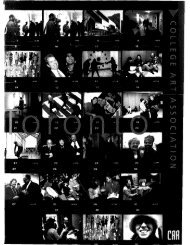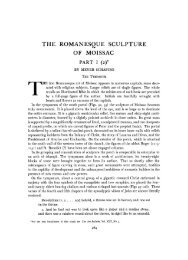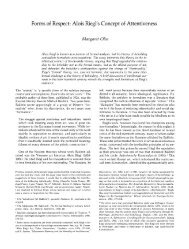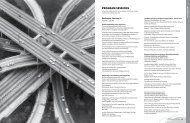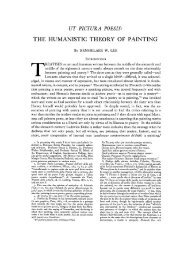Tragic Pompeii - College Art Association
Tragic Pompeii - College Art Association
Tragic Pompeii - College Art Association
You also want an ePaper? Increase the reach of your titles
YUMPU automatically turns print PDFs into web optimized ePapers that Google loves.
228 THE ART BULLETIN JUNE 1994 VOLUME LXXVI NUMBER 2<br />
Al I<br />
..........<br />
.......<br />
..............MI,<br />
4 Frontispiece from F. Niccolini, Le case ed i monumenti di Pom-<br />
pei disegnati e descritti, I, Naples, 1854-96<br />
First, the urge to document and record the remains as they<br />
were found informs the volumes of H. Roux Ain6 and J.<br />
Barre (1839-40), W. Zahn (1829, 1859), and F. Niccolini<br />
(1854-96), as well as numerous loose engravings, watercol-<br />
ors, and temperas. The most thorough treatment to date is<br />
still that by the Frenchman, D. Raoul-Rochette, whose text of<br />
1828 with its watercolors and drawings, now itself frag-<br />
mented and divided between Rome and Paris, offers invalu-<br />
able evidence of the house before its disassembly, weather-<br />
ing, and final rebuilding.12<br />
The other desire was a creative, or rather re-creative, urge<br />
to make the fragment whole, seen in the engraving by Sir<br />
William Gell, whose Pompeiana of 1832 became a best-selling<br />
handbook for English tourists (Fig. 5). Using a pane of glass,<br />
Gell traced an original drawing of the house, outfitted the<br />
12 H. Roux Aine and M. L. Barre, Herculaneum et Pompe'i. Recueil gendral<br />
des peintures, bronzes, mosaiques, etc., Paris, I, 1840, 94-103; 11, 1839,<br />
216-225; III, 1840, 3-5, 30-31, 56-57, 90-91; W. Zahn, Die schdnsten<br />
Ornamente und merkwiirdigsten Gemalde aus Pompei, Herculaneum und<br />
Stabiae, I, Berlin, 1829, pls. 20, 23, 33, 43; II, 1859, pls. 10, 17, 42, 59; F.<br />
Niccolini, Le case e i monumenti di Pompei disegnati e descritti, Naples,<br />
1854-96, I, 1-16, pls. 1-6; D. Raoul-Rochette, Choix des monuments<br />
inidits. I. Maison du Poete Tragique a Pompei, Paris, 1828.<br />
interior in period style, and inserted the ancient Pompeians<br />
themselves. This reanimation of the house inspired the<br />
dwelling of Edward Bulwer-Lytton's protagonist Glaucus in<br />
The Last Days of <strong>Pompeii</strong> (1832), which was dedicated to Gell.<br />
Carefully described in all its parts, parts given Latin names,<br />
Bulwer-Lytton's verbal reconstruction would spawn numer-<br />
ous additional examples in prints, paintings, and films for<br />
the next century.'3<br />
In France too, archaeology and fiction combined to repro-<br />
duce the house. A photograph by Alfred-Nicolas Normand,<br />
architect of Prince Jerome Napoleon, is today an important<br />
document of surviving details in 1851; yet his aim was not to<br />
record the house but to use it as a model in designing the<br />
prince's Pompeian Palace on the rue Montaigne in Paris.<br />
There Jerome Napoleon and his friends emulated what they<br />
imagined had been a Pompeian life of elegant leisure by<br />
dressing in togas and enjoying ancient skits. Gustave Bou-<br />
langer captured just such a scene in his Rehearsal of "The Flute<br />
Player" in the Atrium of the House ofH.I.H. The Prince Napoleon,<br />
1861 (Fig. 6). The composition is freely based upon the<br />
mosaic emblema from the tablinum floor of the House of the<br />
<strong>Tragic</strong> Poet (Fig. 7), and was rendered in an academic,<br />
illusionistic style that captured the palace's amalgam of past<br />
and present just as the ancient Roman house had appropri-<br />
ated the forms of the more ancient Greek culture.14<br />
Indeed, it was the very illusionism of the decor in the<br />
House of the <strong>Tragic</strong> Poet that stirred the nineteenth-century<br />
memory of another literary source, Petronius's Satyricon,<br />
written about the time the interior was decorated.'5 The<br />
13 W. Gell, Pompeiana: The Topography, Edifices and Ornaments of <strong>Pompeii</strong>,<br />
the Result of the Excavations since 1819, I, London, 1835, 142-178; II,<br />
95-122; the reconstruction of the atrium: pl. xxxvii, 96-99; E. Bulwer-<br />
Lytton, The Last Days of <strong>Pompeii</strong>, London, 1832, chap. 3. To this list must<br />
be added at least four built models of the house, including one made for<br />
Mussolini's Mostra Augustea of 1938, now in the Museo della Civilta<br />
Romana; see Bragantini, 164, and B. Andreae, "Modelle pompejanischer<br />
Bauten," Pompeji: Leben und Kunst in den Vesuvstddten, exh. cat.,<br />
Villa Hugel, Essen, 1975, 215, 250. On the European reception of<br />
<strong>Pompeii</strong>, see W. Leppmann, <strong>Pompeii</strong> in Fact and Fiction, London, 1968;<br />
E. C. Corti, The Destruction and Resurrection of <strong>Pompeii</strong> and Herculaneum,<br />
London, 1951; R. Trevelyan, The Shadow of Vesuvius: <strong>Pompeii</strong> AD 79,<br />
London, 1976; R. Brilliant, <strong>Pompeii</strong> A.D. 79: The Treasure of Rediscovery,<br />
New York, 1979, and on this house: 107-108, 141-173; Pompe'i<br />
1748-1980, 11-56; Pompei. Travaux et envois des architectes frangais au<br />
XIX siecle, exh. cat., Ecole Nationale Superieure des Beaux-<strong>Art</strong>s, Paris,<br />
1981; Pompei e gli architettifrancesi dell '800, Naples, 1981.<br />
4 Alfred-Nicolas Normand: Architecte, photographies de 1851/52, exh. cat.,<br />
Archives Photographiques de la Direction de l'Architecture, Paris, 1978,<br />
19, no. 54; Prince Napoleon's Palace: T. Gautier, Le Palais pomplien:<br />
Etudes sur la maison greco-romaine, Paris, 1861; M.C. Dejean de la Batie,<br />
"La Maison pompeienne du Prince Napoleon Avenue Montaigne,"<br />
Gazette des beaux-arts, LXXXVII, 1976, 127-34; The Second Empire 1852-<br />
1870: <strong>Art</strong> in France under Napoleon III, exh. cat., Philadelphia Museum of<br />
<strong>Art</strong>, 1978, 63-64; on Boulanger: 59-60.<br />
'15 The paintings of the House of the <strong>Tragic</strong> Poet have been dated, by<br />
style, both to the Neronian and the Vespasianic periods. I follow the<br />
Neronian dating based on the close similarity between features of the<br />
surrounding decoration, in particular the black frieze of the atrium, and<br />
that of the Temple of Isis in <strong>Pompeii</strong>, whose restoration is securely dated<br />
by an inscription to A.D. 62. An execution after A.D. 68 would not<br />
substantially alter my interpretation. On the problematic dating of the<br />
Fourth Style: V. M. Strocka, "Die r6mische Wandmalerei von Tiberius<br />
bis Nero," Pictores per provincias (Aventicum v), 1987, 29-44; R. Thomas,<br />
"Zur Chronologie des dritten und vierten Stils," KdlnerJahrbuch fiir Vorund<br />
Friihgeschichte, xxiv, 1991, 153-158; R. Ling, "German Approaches<br />
to <strong>Pompeii</strong>,"Journal of Roman Archaeology, vi, 1993, 331-340.



